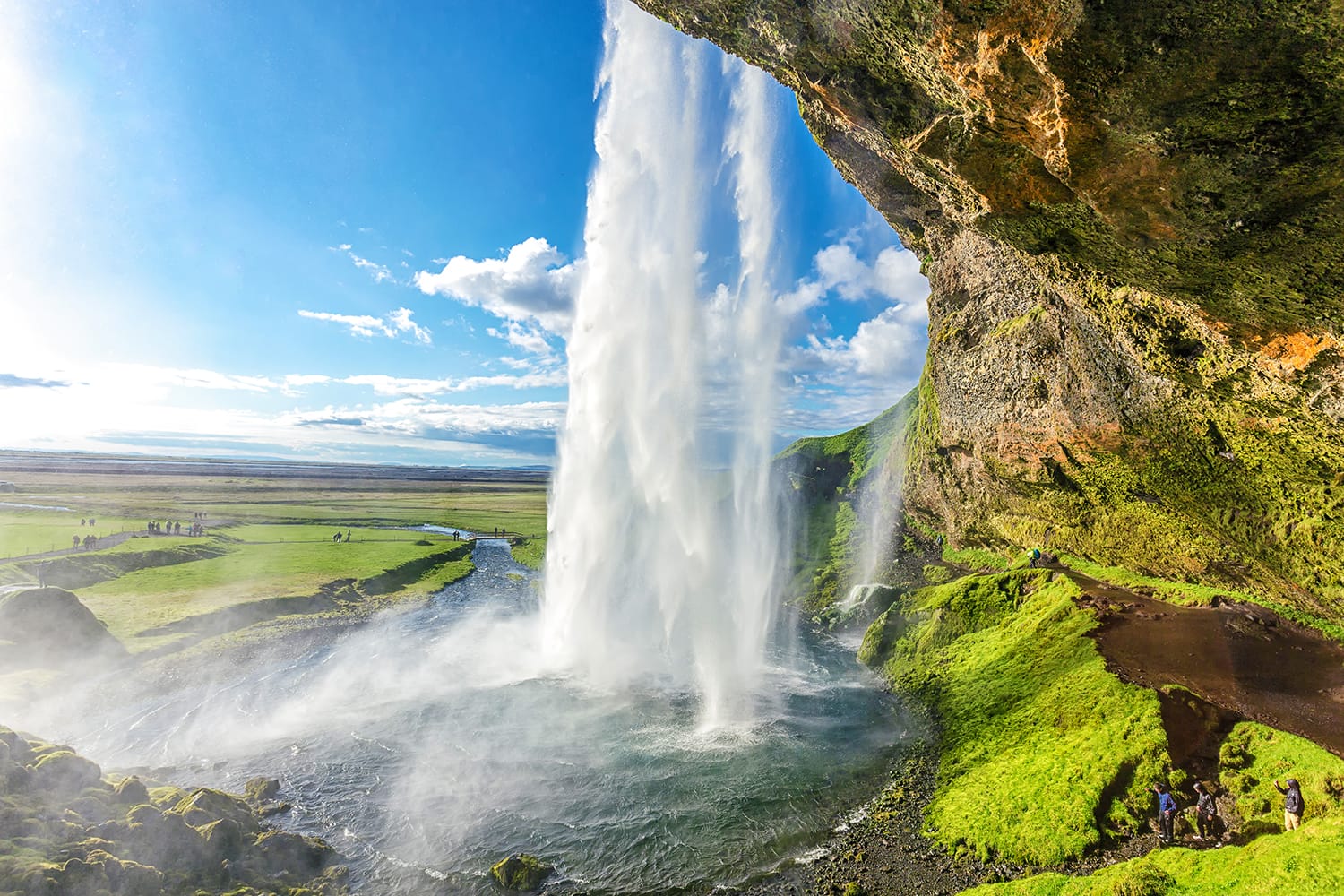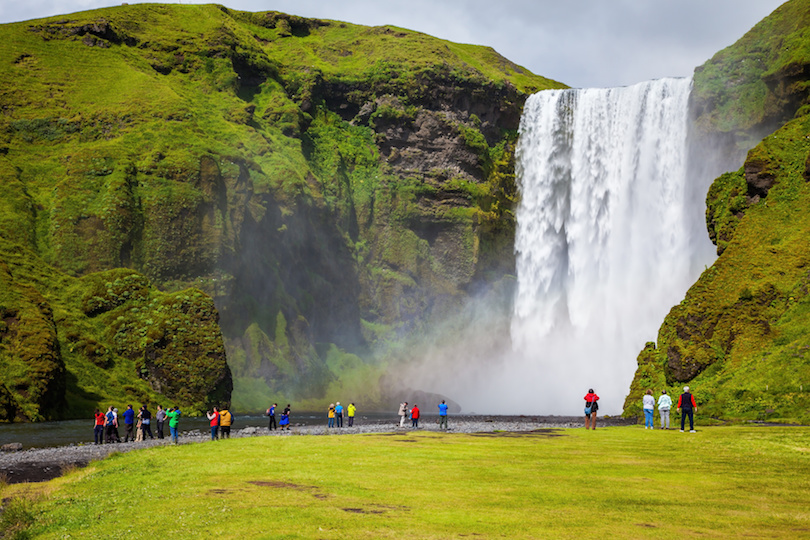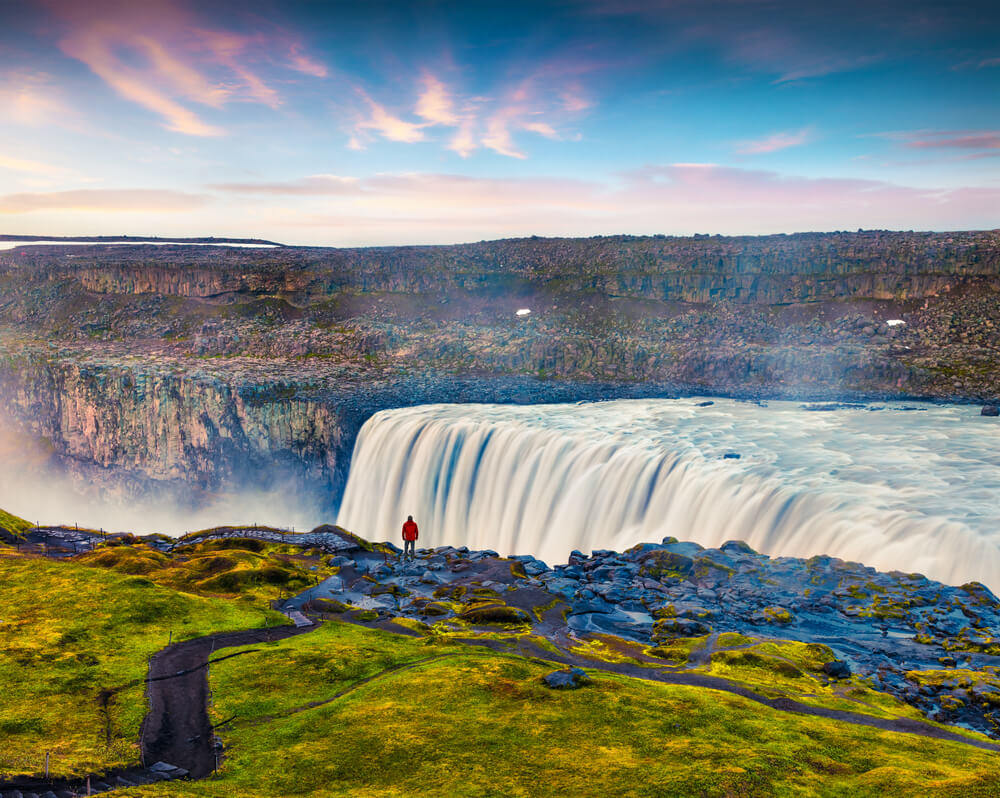
Iceland, a sparsely populated island nation in the North Atlantic, is a place of stark contrasts and breathtaking natural beauty. Often dubbed the "Land of Fire and Ice," it boasts a dramatic landscape shaped by volcanic activity and glacial forces, offering an unparalleled adventure for travelers seeking the extraordinary. From cascading waterfalls and steaming geysers to shimmering glaciers and the ethereal dance of the Northern Lights, Iceland promises an unforgettable journey into a world unlike any other. This comprehensive guide will delve into the country’s top attractions, its fascinating history, practical travel tips, accommodation options, transportation, and the optimal times to experience its magic.
The Crown Jewels: Iceland’s Top Attractions
Iceland’s allure lies in its raw, untamed natural wonders. Here are some of the most iconic and awe-inspiring attractions that draw visitors from across the globe:

Related Articles about Iceland: A Land of Fire and Ice – Unveiling Its Top Attractions and Essential Travel Guide:
- Emerald Dreams and Bespoke Stays: Unveiling Ireland’s Best Hotels and Unforgettable Experiences
- Turkey: A Tapestry of Wonders – Unveiling Its Top Attractions, Rich History, and Essential Travel Guide
- Montreal: A Symphony of Culture, History, and Culinary Delights
- Manchester: A City of Grit, Glamour, and Groundbreaking Culture
- Land of a Thousand Lakes and Northern Lights: Unveiling Finland’s Top Attractions
1. The Golden Circle: This popular tourist route is a must-do for any first-time visitor, encompassing three of Iceland’s most celebrated natural landmarks within a relatively short drive from Reykjavík.
- Þingvellir (Thingvellir) National Park: A UNESCO World Heritage site, Þingvellir is not only geologically significant as the visible boundary between the North American and Eurasian tectonic plates, but it also holds immense historical importance as the site of Iceland’s ancient parliament, the Alþingi, established in 930 AD. Walking between the tectonic plates is a surreal experience, and the park’s rift valley is a testament to Earth’s dynamic forces.
- Geysir Geothermal Area: Witness the raw power of the Earth at the Haukadalur valley, home to the Great Geysir (though largely dormant now) and its more active neighbor, Strokkur. Strokkur erupts every 5-10 minutes, shooting a column of superheated water and steam up to 20 meters into the air – a truly spectacular sight.
- Gullfoss Waterfall: "The Golden Falls" is a majestic two-tiered waterfall that plunges into a deep canyon, creating a mesmerizing spray and often, a vibrant rainbow. Its sheer power and beauty are humbling.
2. The Blue Lagoon: A world-renowned geothermal spa, the Blue Lagoon is an iconic Icelandic experience. Its milky-blue, mineral-rich waters, heated naturally by geothermal energy, are renowned for their healing properties. Surrounded by a surreal lava field, bathing in the warm waters, perhaps with a silica mud mask, is a truly rejuvenating and unforgettable experience, especially during the cooler months.
3. Jökulsárlón Glacier Lagoon & Diamond Beach: Located in the southeast, Jökulsárlón is a breathtaking glacier lagoon filled with icebergs that have calved from the Breiðamerkurjökull glacier. The icebergs, in various shades of blue and white, drift serenely towards the sea. Adjacent to the lagoon is Diamond Beach, where ice chunks wash ashore onto the black sand, sparkling like diamonds under the sun. Boat tours among the icebergs offer an up-close encounter with these magnificent frozen sculptures.
4. Skógafoss Waterfall: Another of Iceland’s most impressive waterfalls, Skógafoss is a powerful, wide cascade that plunges 60 meters from a cliff. Legend has it that a Viking settler hid a chest of gold behind the falls, and on sunny days, the mist often creates single or double rainbows. You can walk right up to the base of the falls for a truly immersive experience.

5. Seljalandsfoss Waterfall: What makes Seljalandsfoss unique is the path that allows visitors to walk behind the curtain of water. This offers a completely different perspective and an exhilarating feeling of being enveloped by nature’s power. Be prepared to get a little wet!
6. Reynisfjara Black Sand Beach: Near the village of Vík í Mýrdal, Reynisfjara is a dramatic black sand beach famous for its powerful waves, basalt columns (Reynisdrangar sea stacks), and vast cave. The stark beauty of the black sand against the white foam of the crashing waves is truly captivating, but caution is advised due to the dangerous sneaker waves.
7. Vatnajökull National Park: This vast national park, covering over 14% of Iceland, is home to Europe’s largest glacier, Vatnajökull. It offers a plethora of activities, including glacier hiking, ice caving (seasonally), and exploring its diverse landscapes, from ice caps to volcanic areas.
8. The Northern Lights (Aurora Borealis): While not a physical attraction, witnessing the Northern Lights is arguably the most sought-after experience in Iceland during the winter months. These celestial displays of vibrant colors dancing across the night sky are a magical phenomenon, best viewed away from city lights on clear, dark nights.
9. Mývatn Nature Baths & Lake Mývatn: In the north of Iceland, the Mývatn region is a hub of geothermal activity and natural beauty. Lake Mývatn itself is a birdwatcher’s paradise, surrounded by pseudocraters and lava formations. The Mývatn Nature Baths offer a more relaxed and less crowded alternative to the Blue Lagoon, with its own mineral-rich geothermal waters.
10. Snæfellsnes Peninsula: Often referred to as "miniature Iceland," the Snæfellsnes Peninsula offers a concentrated sample of the country’s diverse landscapes. Highlights include the iconic Kirkjufell mountain, black sand beaches, charming fishing villages, and the majestic Snæfellsjökull glacier-volcano, which inspired Jules Verne’s "Journey to the Center of the Earth."
A Glimpse into Iceland’s Rich History
Iceland’s history is as dramatic and resilient as its landscapes. Its story begins with the arrival of Norse settlers, primarily from Norway, in the late 9th century, seeking new lands and fleeing political turmoil.
- The Viking Age (870s – 1030): Ingólfr Arnarson is credited as the first permanent settler. The establishment of the Alþingi at Þingvellir in 930 marked a significant milestone, creating one of the world’s oldest parliamentary institutions. This era saw the sagas, epic tales of settlers and their struggles, being composed.
- Christianization (circa 1000 AD): Christianity was peacefully adopted as the official religion, a testament to Iceland’s unique societal evolution.
- The Commonwealth Period (930 – 1262): This was a period of relative independence and self-governance, marked by the development of Icelandic law and society.
- Norwegian and Danish Rule (1262 – 1944): Iceland gradually came under Norwegian, and later Danish, rule. This period was often challenging, with natural disasters, economic hardship, and the Danish trade monopoly significantly impacting the island.
- Independence Movement and Republic (20th Century): The 20th century saw a strong push for independence. Iceland regained its sovereignty from Denmark in 1918, becoming a sovereign state in personal union with the Danish monarch. Full independence was declared on June 17, 1944, during World War II, when Denmark was occupied.
- Modern Iceland: Since gaining full independence, Iceland has developed into a modern, prosperous nation with a strong focus on environmental sustainability, renewable energy, and a thriving tourism industry.
Navigating Iceland: Essential Travel Tips
To make the most of your Icelandic adventure, consider these practical tips:
- Book in Advance: Iceland is a popular destination, especially during peak seasons. Book flights, accommodations, and popular tours well in advance to secure your preferred options and potentially better prices.
- Pack Layers: The Icelandic weather is notoriously unpredictable. Pack versatile clothing that can be layered. Waterproof and windproof outer layers are essential, even in summer. Thermal base layers, fleeces, hats, gloves, and sturdy waterproof hiking boots are must-haves.
- Respect Nature: Iceland’s natural environment is fragile. Stay on marked trails, do not litter, and avoid disturbing wildlife or geological formations. Off-roading is strictly prohibited outside designated areas.
- Embrace the Unexpected: Weather can change rapidly, and road conditions can be affected by snow or ice, especially outside of summer. Be flexible with your itinerary and have backup plans.
- Learn a Few Icelandic Phrases: While English is widely spoken in tourist areas, learning a few basic Icelandic phrases like "Halló" (Hello), "Takk" (Thank you), and "Góðan daginn" (Good day) is always appreciated.
- Currency and Payments: The currency is the Icelandic Króna (ISK). Credit and debit cards are widely accepted throughout the country, even in remote areas. It’s advisable to carry a small amount of cash for smaller purchases or in case of emergencies.
- Tap Water is Excellent: Iceland’s tap water is pure, safe, and delicious. Bring a reusable water bottle to save money and reduce plastic waste.
- Daylight Hours Vary Dramatically: Be aware of the extreme variations in daylight hours. In summer, you’ll experience the Midnight Sun, with nearly 24 hours of daylight. In winter, daylight is limited, offering more opportunities for Northern Lights viewing.
- Driving in Iceland: If you plan to rent a car, be aware of road conditions. The Ring Road (Route 1) is mostly paved, but many highland roads (F-roads) require a 4×4 vehicle and are only open during the summer months. Familiarize yourself with Icelandic road signs and regulations.
Accommodation Options: From Cozy Guesthouses to Unique Stays
Iceland offers a diverse range of accommodation to suit every budget and preference:
- Hotels: Available in cities and larger towns, offering varying levels of comfort and amenities. Reykjavík has the widest selection.
- Guesthouses & B&Bs: A popular choice for a more intimate and local experience. Often run by families, they provide a warm and welcoming atmosphere.
- Farm Stays: Immerse yourself in rural Icelandic life by staying on a working farm. This offers a unique opportunity to connect with the land and its inhabitants.
- Hostels: Budget-friendly options, particularly in Reykjavík and other popular tourist hubs, offering dormitory beds and private rooms.
- Apartments & Vacation Rentals: Ideal for families or longer stays, providing self-catering facilities and more space.
- Camping: During the summer months, camping is a popular and affordable option. Numerous campsites are available throughout the country, offering basic facilities.
- Unique Stays: Iceland boasts some truly distinctive accommodation, from glass igloos offering Northern Lights views to remote cabins and converted lighthouses.
Getting Around Iceland: Choices for Every Traveler
Transportation in Iceland depends on your itinerary and preferences:
- Rental Car: The most popular and flexible way to explore Iceland, especially if you want to venture off the beaten path. This allows you to set your own pace and stop at your leisure. Remember to consider a 4×4 if you plan to explore the highlands.
- Public Buses: A network of buses connects major towns and cities. This can be a more budget-friendly option for those sticking to the main routes. However, schedules can be limited, especially outside of peak season.
- Organized Tours: For those who prefer not to drive or want expert guidance, numerous organized tours are available, ranging from day trips to multi-day adventures covering specific regions or activities.
- Domestic Flights: For longer distances, domestic flights can save time, especially to destinations like Akureyri in the north or the Westfjords.
- Ferries: Ferries are essential for reaching islands like the Westman Islands or the remote Westfjords.
The Best Time to Visit Iceland: A Tale of Two Seasons
Iceland’s appeal shifts dramatically with the seasons, offering distinct experiences:
-
Summer (June to August): This is the peak tourist season, characterized by the Midnight Sun, long daylight hours, and milder temperatures (averaging 10-13°C or 50-55°F). Roads are generally clear, and most attractions and activities are accessible. It’s ideal for hiking, exploring the highlands, and enjoying outdoor activities. However, it’s also the most crowded and expensive time to visit.
-
Autumn (September to October): As the crowds thin and daylight hours begin to shorten, autumn offers a beautiful transition. The landscapes are painted with vibrant fall colors, and the chances of witnessing the Northern Lights increase. Temperatures are cooler, and prices may start to decrease.
-
Winter (November to March): This is the prime time for Northern Lights hunting. Days are short, with only 4-6 hours of daylight in December and January. Snowfall can impact road conditions, and some highland roads will be inaccessible. However, the snowy landscapes are incredibly picturesque, and activities like ice caving and glacier tours are at their best. It’s also the most affordable time to visit.
-
Spring (April to May): Spring brings a gradual return of longer daylight hours and the thawing of snow. While the Northern Lights are still possible in early spring, the weather can be unpredictable. Landscapes begin to bloom, and birdlife becomes more active. It offers a good balance of fewer crowds and increasing accessibility.
In conclusion, Iceland is a destination that ignites the imagination and soothes the soul. From the raw power of its geological wonders to the ethereal beauty of the Aurora Borealis, the Land of Fire and Ice offers an unparalleled travel experience. By understanding its history, embracing its unique culture, and planning wisely, you can embark on an adventure that will leave you with memories to last a lifetime.





